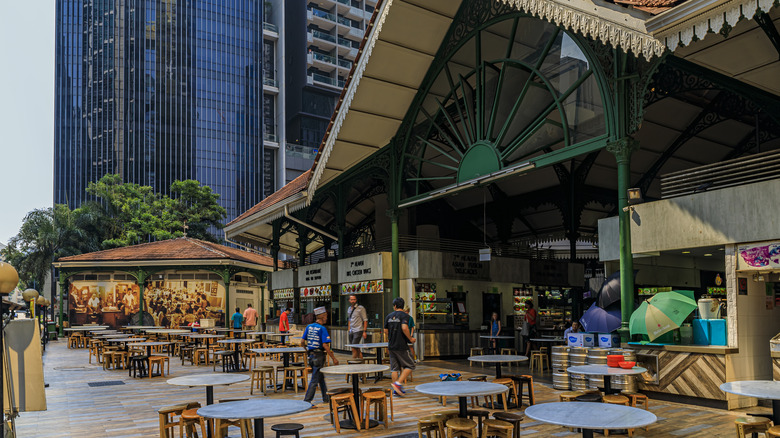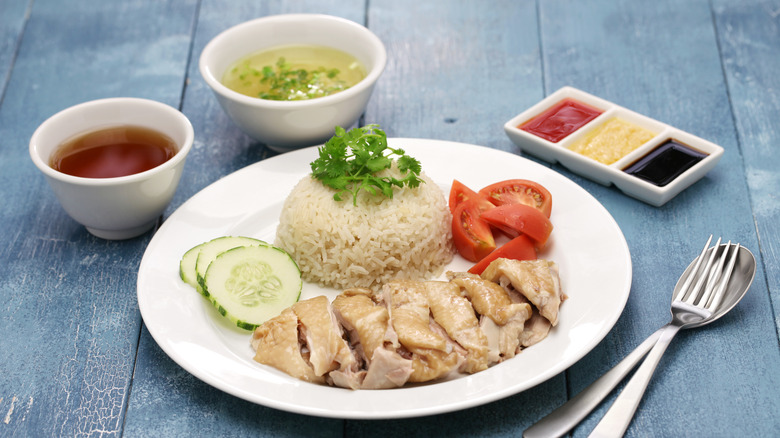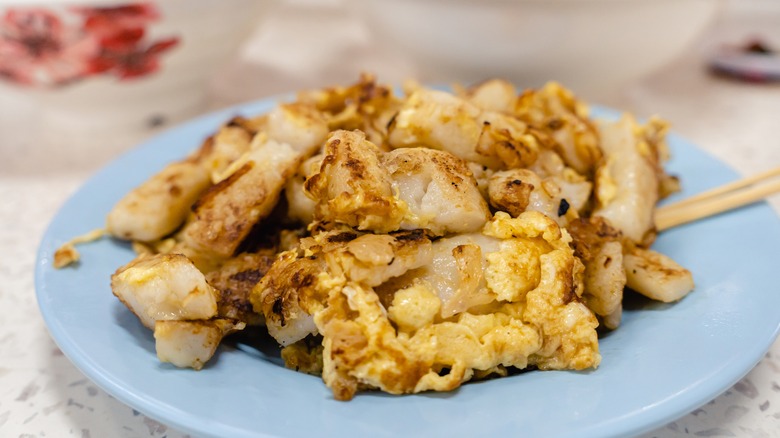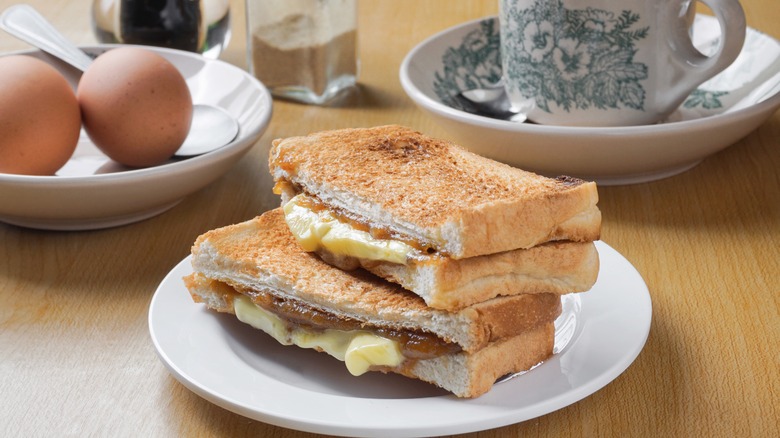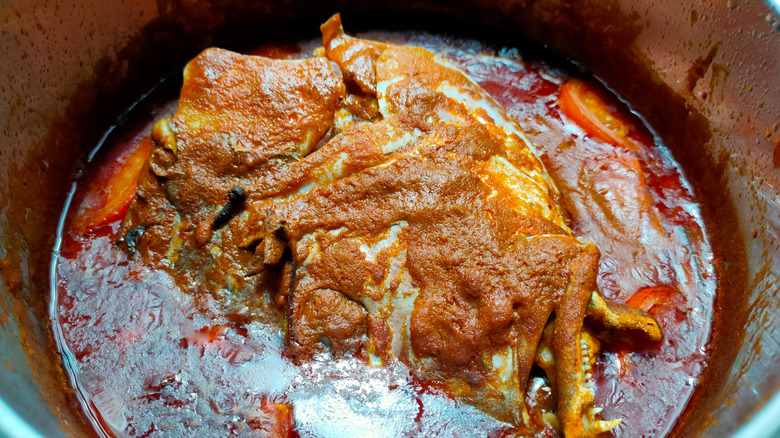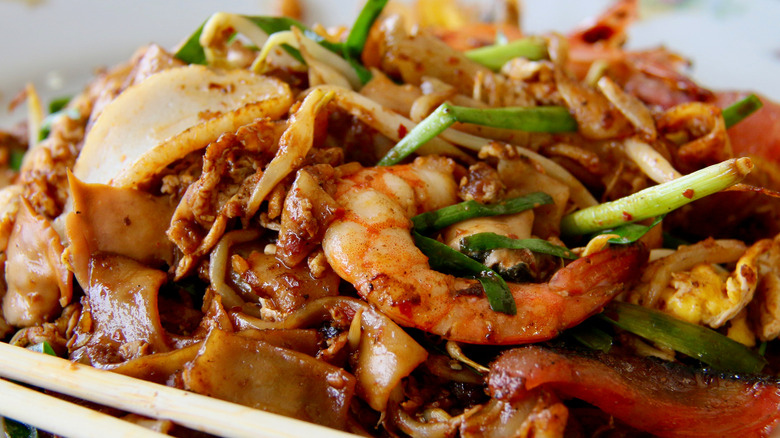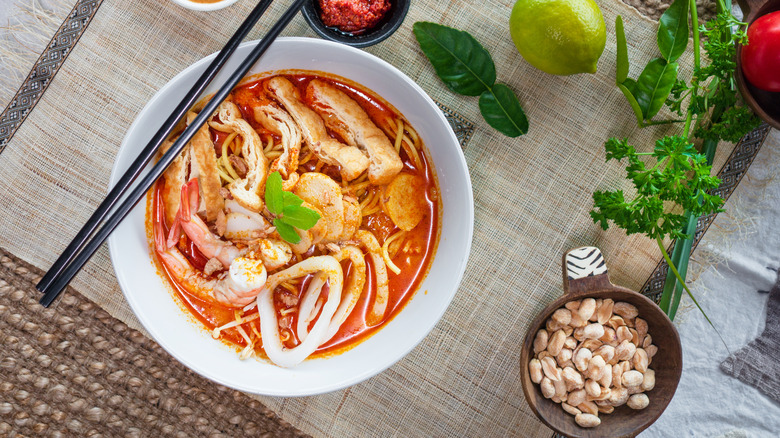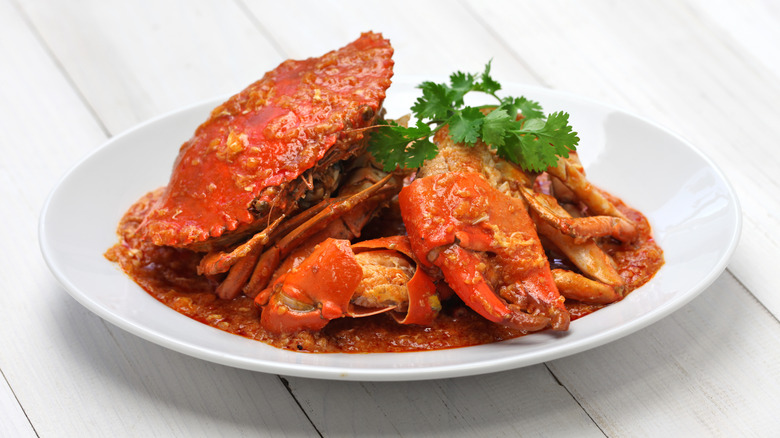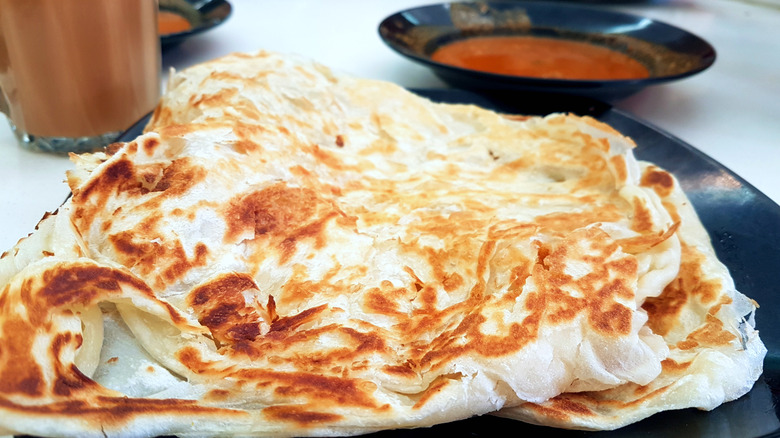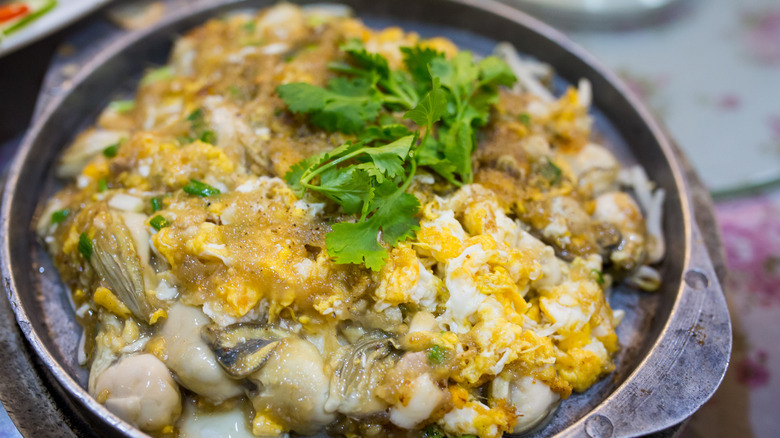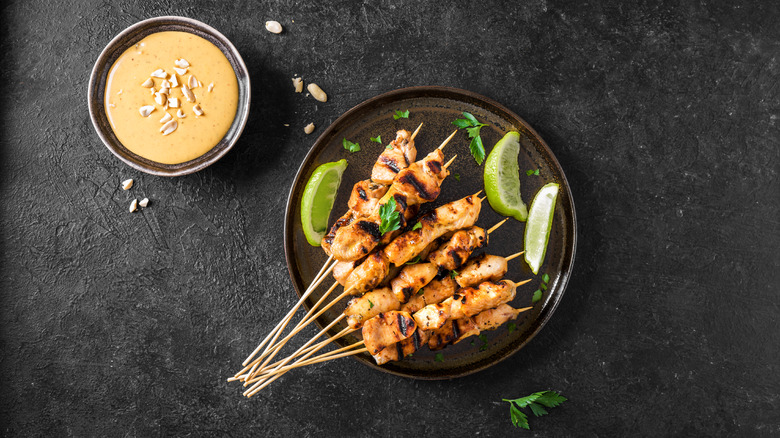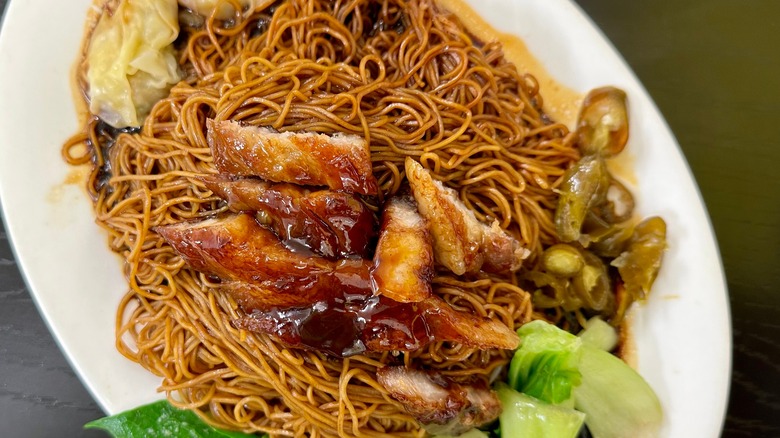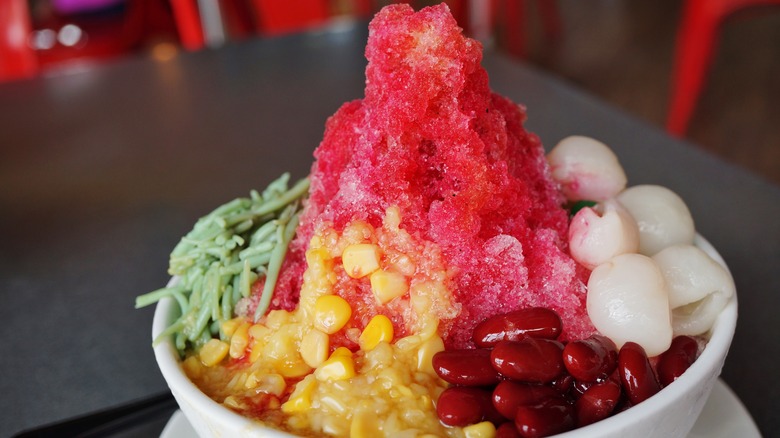The 12 Street Foods That Define Singapore
Singapore is a country of unexpected contrasts. While it's a hyper-modern, industrialized nation that has aggressively embraced Westernization, it's also a proudly multicultural community where Chinese, Indian, Malay, and European populations have co-existed and shared their food cultures for centuries.
This cultural mix gifted Singapore with a vibrant food culture that draws visitors from around the world to sample its distinct dishes, which typically combine influences from the country's different populations. When it comes to food, Singaporeans make flavor their top priority. While the country boasts an educated populace of well-paid professionals who could easily afford white-tablecloth meals, serious food lovers among them will tell you the best food comes from humble stalls run by specialists who've mastered the nuances of a single dish or two. As a result, Singapore's traditional street food culture is thriving. However, don't expect to find any food in the streets — actual street vending has long been outlawed, and vendors moved into dedicated, government-run hawker centers where diners can choose from an array of treats and enjoy them at tables maintained by the centers. As you can imagine, it's a lot to take in. Here are a few classic dishes to know and look out for.
Hainan chicken rice
The old saying "you can't judge a book by its cover" also applies to food. Often, the must unremarkable-looking dishes can turn out to be the most transcendent. An example of this is Hainan chicken rice, a humble-looking dish of poached chicken accompanied by rice cooked in the broth of the chicken and enriched with chicken fat. The dish, as is name implies, originated in Hainan, China, and was brought to Singapore by Chinese immigrants from that region.
While the dish still strongly resembles the Chinese original, it has picked up a number of distinctive local touches. Singaporean cooks, for instance, top their cooked, cut-up chicken with a splash of a sweet-salty, soy-based sauce, while Chinese cooks serve the chicken plain. Singaporean cooks also season their rice with pandan and lemongrass along with chicken broth, adding a distinct, tropical note. In addition, while both Chinese and Singaporean cooks serve chicken rice with dipping sauces, such as a mixture of grated ginger and soy, Singaporean cooks often offer multiple dips containing ingredients such as chilis and calamansi juice. If the idea of plain, boiled chicken still seems too dull, some Singaporean vendors deep-fry their chickens after poaching to add extra color and crunch.
Carrot cake
Don't let the name of this dish throw you off: There are no carrots (nor cream cheese frosting, nor nuts) in this Singaporean street food classic. Rather, the dish's English name is the result of sloppy translation. The Hokkien Chinese name of the dish, chai tow kway, can be literally translated as "carrot cake," since chai tow can mean either "radish" or "carrot" and kway refers to a cake or pastry. Thus, this so-called carrot cake is actually a savory pudding made with shredded daikon, preserved turnip, rice flour, and seasonings.
While the dish is thought to have been introduced by immigrants from south China, the versions served in Singapore differ from the original in a number of ways. While the Chinese version typically includes meats such as chopped, Chinese-style sausage and minced, dried shrimp, Singaporean versions are typically vegetarian-friendly. While the mixture is cut into chunks and pan-fried until crispy on the outside in both versions, Chinese turnip cakes are cut into playing card–sized rectangles, while Singaporean carrot cake comes as a platter of fried, bite-sized cubes. In addition, Singaporean cooks offer the option of ordering carrot cake black (sauteed in dark soy sauce) or white (fried without soy sauce, but sometimes with egg).
Kaya toast and eggs
As much as many food-loving travelers look forward to exploring new dishes and breaking out of their comfort zones, doing so first thing in the morning while jet-lagged and before they've had their first cup of coffee might feel like a bridge too far. Still, the idea of grabbing just a bowl of cornflakes at the hotel breakfast buffet feels like a cop-out — you've seriously traveled halfway around the world to eat that?
For such occasions, the perfect breakfast awaits sleepy visitors to Singapore: kaya toast served with soft-boiled eggs. This classic breakfast treat consists of a sandwich of toast, butter, and kaya, a sweet, custard-like jam made with coconut milk, eggs, sugar, and pandan leaves. By tradition, kaya toast is served with soft-boiled eggs seasoned with dark soy sauce and white pepper. The combination of savory eggs and sweet toast offers both easy-to-eat comfort and a gentle, welcoming taste of local culture. And, it goes great with a strong cup of local coffee or tea.
Fish head curry
Here's a secret that hardcore seafood lovers keep to themselves: The very tastiest morsels in any fish are, in fact, in its head. This is why ingredients such as halibut cheeks and yellowtail collars have been making appearances on high-end menus, often commanding steep prices. Fish cheeks are known to seafood lovers for their juiciness and tenderness, and fish collars — the bony cut directly behind the gills — are popular in Asia for their richness and flavor.
Chinese diners have long appreciated all that fish heads have to offer, and instead of viewing them as discards or desperation food, they historically saw them as treats for the elite. One legend says that some nobles refused to eat any part of a fish that wasn't the cheeks. Singapore's fish head curry is a characteristic product of the country's penchant for cross-cultural fusion: In the 1940s, a restaurant owner with roots in south India added fish heads to a spicy, Indian curry to appeal to his Chinese customers. The dish has since become a hit with diners of all backgrounds, winning over the country's fish-head doubters.
Char kway teow
At first glance, char kway teow, another hawker stall favorite, doesn't look like much. It's just a plate of stir-fried rice noodles with add-ins such as vegetables, Chinese sausage slices, shrimp, and cooked eggs; not much different from what you'd find in a typical Asian restaurant in the U.S. What makes it memorable — and a sought-after dish among Singaporean diners — is its punchy flavor, contributed by dark soy sauce, oyster sauce, and shrimp paste. It also has characteristic smoky char, the result of quick cooking in a well-seasoned wok over extremely high heat.
In short, it's a simple-looking dish that punches above its weight. Despite its appearance, it's deceptively tricky to make for home cooks — without the right ingredients, a high-powered wok, a deft hand, and a flawless sense of timing, the risk of ending up with a mass of broken, soggy noodles is dangerously high. Like many street food favorites in Singapore, it's the product of multiple cultures. While it originated in south China (ingredients such as Chinese sausage and the technique of high-heat stir-frying reveal its origins), it was enthusiastically adopted in Malaysia and by the Malay population in Singapore, which now considers it a distinctly Malaysian dish. Today, if you order it in Singapore, it'll often be served on a banana leaf — a clear sign of this influence.
Laksa
Another must-try local classic, laksa, can be described as Singapore's geography in a bowl. This hearty, soupy dish is a bowl of Chinese noodles (wheat, rice, or a combination of both) in a spicy, coconut-based broth laden with seafood, fried bean curd puffs, and crunchy bean sprouts. It showcases the culinary contributions of the country's Chinese and Malaysian communities, as well as the island nation's fondness for seafood.
Laksa is one of many favorite dishes rooted in Singapore's Peranakan culture and cuisine, which evolved from the intermarriage of Chinese and Malaysian Singaporeans and the melding of cooking techniques and ingredients from both cultures. The most popular version of the dish features a curry-like, coconut milk broth flavored with powerful ingredients such as garlic, chilis, lemongrass, dried shrimp, galangal, and a range of spices. Another version first created in Penang features a tangy, tamarind broth. The popular coconut-based laksa itself comes in numerous variations, with the spice profile, broth thickness, and choice of toppings varying with each cook. If you visit Singapore and want to seek out a good bowl of laksa, ask around — Singaporeans are not afraid to share their opinions when it comes to food, and the suggestions you get will be as varied as your many dining opportunities.
Chili crab
If you love seafood and spice and aren't afraid of getting your hands (and potentially, your clothes) dirty, chili crab needs to be on your must-try list. While it's now considered a classic Singaporean street food and a beloved part of the country's cultural heritage, chili crab is actually a fairly modern dish. It was invented by home cook Cher Yam Tian, who, after perfecting the dish for friends and family in the 1950s, opened a restaurant at their request to share her specialty with others.
Tian's family had guessed correctly that her dish would be a hit: Soon, hawker stalls and restaurants all over Singapore were creating their own versions of the dish, which consists of pieces of crab (still in the shell, consistent with Chinese cooking tradition) stir-fried in a sweet-spicy sauce of tomatoes and chilis along with garlic, shallots, scallions, and sometimes eggs for thickening. It's succulent, but there's no neat way to eat it. You have to pick up the crab pieces with your hands, open them with your teeth and fingers (the shells are pre-cracked, but intact), and extract the tender crab meat while sucking the spicy sauce off the shells (and your fingers). You won't find picks, seafood forks, or bibs at hawker centers, so to truly enjoy your chili crab, lean in and embrace the mess, just as all the happy diners around you will be doing.
Roti prata
Much of Singapore's famed street food is strongly influenced by, if not directly borrowed from, Chinese cuisine. This is unsurprising, given that Singapore's population is 77% ethnic Chinese (per Guide me Singapore). But, Singaporeans of Malaysian and Indian descent have also helped define Singapore's unique food scene, and they too have introduced dishes from their ancestral countries that all Singaporeans now embrace as part of their shared culture.
Among these is roti prata, a flaky, chewy, crispy Indian flatbread that's typically served hot and freshly made with a bowl of curry (which can contain meat, chicken, or vegetables). Diners savor the roti prata and curry together by tearing off bite-sized pieces of the bread and dipping it into the stew. The flatbread's distinctive, flaky texture comes from its ultra-thin, nearly translucent layers created by carefully stretching and folding the dough. Making it requires skill and practice, which is why Singapore's food lovers turn to hawker stall specialists when a craving hits.
Oyster omelet
Cooks and eaters in Singapore happily embrace dishes from across Asia and beyond, which is why a meal at a hawker center can include everything from Chinese stir-fries to Indian flatbreads and Malaysian stews. While Singapore's diners are certainly aware of the ethnic origins of the dishes they enjoy, they don't feel a need to segregate them into separate meals — if they feel like eating them at the same time, they have a place on the table.
Another example of a borrowed dish enthusiastically embraced in Singapore is the oyster omelet, a dish first developed in China by the Hokkien community. The Hokkien were historically traders, and through their travels, they introduced the dish to cooks in Thailand and elsewhere in southeast Asia, as well as in Singapore. It's distinct from omelets as we know them in the West: Rather than being nestled between layers of plain cooked egg, the oysters are embedded in a thin batter of eggs, tapioca and sweet potato flour, and water, then pan-fried. The resulting omelet (which is more like a thick, messy-looking crepe) is crispy on the outside, tender on the inside, and a perfect backdrop for briny, fresh oysters.
Satay
If you frequent Thai restaurants in the U.S., you've probably encountered satay, which are grilled skewers of meat or chicken with a tantalizingly sweet glaze. Diners in Singapore love it for all the same reasons we do: The smell of the smoke-kissed, faintly caramelized meat skewers being grilled over a live fire is irresistible, as is their flavor.
Like much of Singapore's food, satay had to take a roundabout journey to become a local favorite. It was thought to have been invented by street vendors in Java, Indonesia, and inspired by Indian kebabs (Indian traders had a regular presence in Indonesia and may have introduced some of their food culture). From there, satay spread and became popular throughout the region, and Singapore's cooks and eaters were happy to embrace it. Traditionally made and sold by Chinese, Malay, and Indian Muslim vendors, satay is now enjoyed by Singaporeans of all backgrounds. In Singapore, the spiced meat (or seafood) skewers are served with a range of dipping sauces (including a peanut-based sauce and a pineapple puree), along with cubes of compressed rice, cucumber, and onion slices. Because the skewers are typically sold by the dozen, satay is a dish meant for sharing.
Wonton mee
Frequent visitors to Cantonese restaurants know wonton mee, or wonton noodles, as a bowl of flavorful, clear broth loaded with thin egg noodles and silky wontons. It's as much a soup as a pasta dish, and one needs both a spoon and chopsticks (or a fork) to eat it. It's likely that this is the version Chinese immigrants first brought to Singapore, but like many dishes, it gradually evolved to take on a distinctly local flavor.
Thus, if you order wonton mee in Singapore today, it's more likely to be served on a plate than in a bowl. It's a tangle of dry egg noodles and shrimp-filled wontons tossed with a dark, sometimes chili-laced sauce and topped with Chinese-style barbecue pork and greens.
You'll notice slight variations if you visit different vendors — some offer meats such as pork belly along with the barbecued pork, different noodle types (such as thicker egg noodles or even spinach noodles), or offer spicier sauces than the more-common, slightly sweet, and soy-based sauce.
Ice kachang
Singapore's summers can be hot and humid, which means even eaters devoted to the country's many flavorful soups and stews may need something cold and refreshing to keep them comfortable. Even in cooler weather, sometimes a cold, sweet treat is just what you crave after a hot meal. For this, Singaporean food lovers turn to ice kachang, a decadent shaved ice dessert of Malaysian origin.
While the base of a serving of ice kachang is indeed a big pile of shaved ice in a bowl, this dessert is far more substantial than a typical snow cone. The dish's Malaysian name, ais kacang, translates as "iced beans," and yes, there are actual beans (the sweet red beans common in Asian desserts) piled onto the ice. In addition, the dessert typically includes cubes of grass jelly or agar along with your choice of toppings, which can include peanuts, sweet corn, condensed milk, durian, and even ice cream. Both rehydrating and filling, it's a dessert you might be tempted to make into a hot-weather meal in itself.

